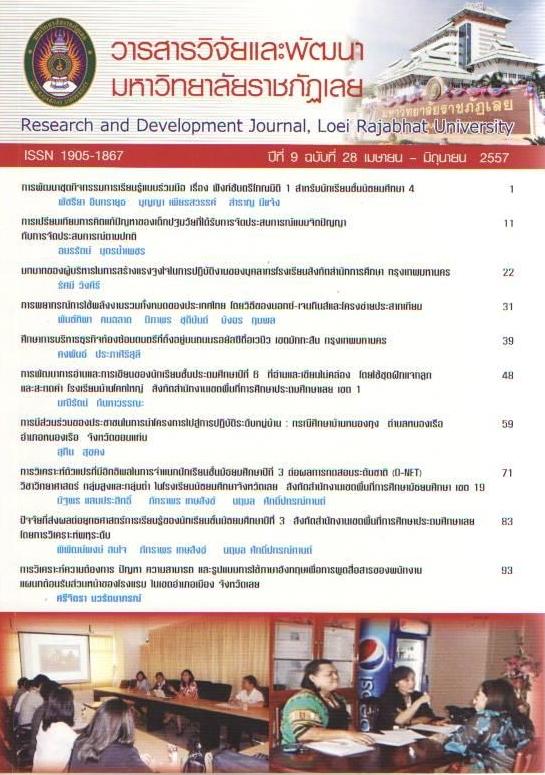ปัจจัยที่ส่งผลต่อยุทธศาสตร์การเรียนรู้ของนักเรียนชั้นมัธยมศึกษาปีที่ 3 สังกัดสำนักงานเขตพื้นที่การศึกษาประถมศึกษาเลย โดยการวิเคราะห์พหุระดับ
คำสำคัญ:
การวิเคราะห์พหุระดับ, ยุทธศาสตร์การเรียนรู้, multi level analysis, learning strategiesบทคัดย่อ
บทคัดย่อ
การวิจัยครั้งนี้มีวัตถุประสงค์เพื่อ 1) ศึกษาความสัมพันธ์ระหว่างตัวแปรอิสระระดับนักเรียน และตัวแปรอิสระระดับโรงเรียนกับยุทธศาสตร์การเรียนรู้ของนักเรียนชั้นมัธยมศึกษาปีที่ 3 2) ศึกษาตัวแปรอิสระระดับนักเรียนที่ส่งผลต่อยุทธศาสตร์การเรียนรู้ของนักเรียนชั้นมัธยมศึกษาปีที่ 3 สังกัดสำนักงานเขตพื้นที่การศึกษาประถมศึกษาเลย 3) ศึกษาตัวแปรอิสระระดับโรงเรียนที่ส่งผลต่อยุทธศาสตร์การเรียนรู้ และสัมประสิทธิ์การถดถอย (Slope) ของนักเรียนชั้นมัธยมศึกษาปีที่ 3 กลุ่มตัว อย่างเป็นผู้บริหารโรงเรียนประถมศึกษา (ขยายโอกาสทางการศึกษา) จำนวน 55 คน ครูที่ปรึกษาในระดับชั้นมัธยมศึกษาปีที่ 3 จำนวน 55 คน และนักเรียนที่กำลังศึกษาในระดับชั้นมัธยมศึกษาปีที่ 3 ปีการศึกษา 2555 จำนวน 1,190 คน จำนวน 55 โรงเรียน รวมจำนวนทั้งสิ้น จำนวน 1,300 คน ซึ่งได้มาโดยการสุ่มแบบ 2 ขั้นตอน เครื่องมือที่ใช้ในการเก็บรวบรวมข้อมูลเชิงปริมาณ เป็นแบบสอบถามเกี่ยวกับ ตัวแปรที่ส่งผลต่อยุทธศาสตร์การเรียนรู้ วิเคราะห์ข้อมูลโดยใช้โปรแกรมคอมพิวเตอร์สำเร็จรูป คำนวณหาค่าความถี่ ร้อยละ ค่าเฉลี่ย ส่วนเบี่ยงเบนมาตรฐาน สัมประสิทธิ์การกระจาย ค่าความเบ้ ความโด่ง สัมประสิทธิ์สหสัมพันธ์เพียร์สัน และทำการวิเคราะห์พหุระดับด้วยโปรแกรมสำเร็จรูป HLM ผลการวิจัยพบว่า
1. ตัวแปรอิสระระดับนักเรียน ที่มีความสัมพันธ์ทางบวกกับยุทธศาสตร์การเรียนรู้ของนักเรียนอย่างมีนัย สำคัญทางสถิติที่ระดับ .01 ได้แก่ การรับรู้ความสามารถของตนเองทางการเรียน การสนับสนุนทางการเรียนของผู้ปกครอง แรงจูงใจใฝ่สัมฤทธิ์ ลักษณะมุ่งอนาคต และเจตคติทางการเรียน ตัวแปรอิสระระดับโรงเรียน ที่มีความสัมพันธ์ทางบวกกับยุทธศาสตร์การเรียนรู้ของนักเรียนอย่างมีนัยสำคัญทางสถิติที่ระดับ .01 ได้แก่ การจัดการเรียนการสอนที่เน้นผู้เรียนเป็นสำคัญ คุณภาพการสอนของครู ขนาดของโรงเรียน อัตราส่วนของครูต่อนักเรียน ที่ระดับ .05 ได้แก่ ความเป็นผู้นำทางวิชาการของผู้บริหาร แหล่งทรัพยากรการเรียนรู้ในโรงเรียน บรรยากาศทางการเรียนระดับการศึกษาของผู้บริหาร และประสบการณ์บริหารของผู้บริหาร
2. ตัวแปรอิสระระดับนักเรียนที่ส่งผลต่อยุทธศาสตร์การเรียนรู้ของนักเรียนชั้นมัธยมศึกษาปีที่ 3 อย่างมี นัยสำคัญทางสถิติที่ระดับ .01 ได้แก่ เจตคติทางการเรียน แรงจูงใจใฝ่สัมฤทธิ์ การรับรู้ความสามารถของตนเองทาง การเรียน การสนับสนุนทางการเรียนของผู้ปกครอง
3. ตัวแปรอิสระระดับโรงเรียนที่ส่งผลต่อค่าเฉลี่ยยุทธศาสตร์การเรียนรู้ของนักเรียนชั้นมัธยมศึกษาปีที่ 3 อย่างมีนัยสำคัญทางสถิติที่ระดับ .01 ได้แก่ การจัดการเรียนการสอนที่เน้นผู้เรียนเป็นสำคัญ ตัวแปรอิสระระดับโรงเรียนที่ส่งผลต่อค่าเฉลี่ยยุทธศาสตร์การเรียนรู้ของนักเรียนชั้นมัธยมศึกษาปีที่ 3 อย่างมีนัยสำคัญทางสถิติที่ระดับ .05 ได้แก่ คุณภาพการสอนของครู และตัวแปรที่ส่งผลต่อสัมประสิทธิ์การถดถอยของตัวแปรเจตคติทางการเรียน ที่ส่งผลต่อยุทธศาสตร์การเรียนรู้ อย่างมีนัยสำคัญทางสถิติที่ระดับ .05 ได้แก่ อัตราส่วนของครูกับนักเรียน ซึ่งส่งผลทางบวก
Abstract
This research aimed : 1) to find out the relationship between the independent variables of student level and the school level and the Mattayomsuksa 3 students’ learning strategies, 2) to investigate the student level independent variables affected their learning strategies, 3) to acquire the independent variables of the school level affected the learning strategies and regression coefficients (slope). The two-stage random sampling was employ for 1,300 research samples which consisted of 55 administrators, 55 the students’ advisers and 1,190 Mattayomsuksa 3 students from 55 schools under Loei Primary Educational Service Area Office. The research instrument for data collection was a questionnaire which earned data were analyzed to obtain frequency, percentage, mean, standard deviation, coefficient of variation, Pearson’s product moment correlation coefficient and multi level analysis by HLM. The findings showed as follows :
1. The independent variables of the student level which were positive relation to learning strategies with the statistical significance at .01 level were the self efficacy perception of learning, parental support for learning, achievement motivation, future orientation and attitude towards learning. The school level independent variables which were positive relation to the learning strategies with the statistical significance at .01 level were the child –centered learning, quality of instruction, school sizes and the ratio of teachers to students. The school level independent variables which were positive relation to the learning strategies with the statistical significance at .05 level were the academic leadership, learning resources, learning classroom atmosphere, administrator’s education level and the administrative experiences.
2. The student level independent variables affected the learning strategies of Mattayomsuksa 3 students with the statistical significance at .01 level were the attitude towards learning, achievement motivation, self – efficacy perception of learning and parental support for learning.
3. The classroom level independent variables affected the learning strategies with the statistical significance at .01 level was the child – centered learning. And the classroom level independent variables affected the learning strategies with the statistical significance at .05 level was the quality of instruction. The ratio of teachers to students was found that it affected the regression coefficients of the attitude toward learning practice which affected on student learning strategies with the statistical significance at .05 level.
ดาวน์โหลด
รูปแบบการอ้างอิง
ฉบับ
ประเภทบทความ
สัญญาอนุญาต
ข้อความที่ปรากฎในวารสารฉบับนี้เป็นความคิดเห็นของผู้เขียนแต่ละท่าน สถาบันวิจัยและพัฒนา มหาวิทยาลัยราชภัฏเลย และกองบรรณาธิการ ไม่จำเป็นต้องเห็นด้วยและไม่มีส่วนรับผิดชอบใดๆ
สถาบันวิจัยและพัฒนา มหาวิทยาลัยราชภัฏเลย ขอให้ผู้อ่านอ้างอิงในกรณีที่ท่านคัดลอกเนื้อหาบทความในวารสารฉบับนี้






